Protecting Workers from Ultraviolet Radiation - icnirp
Protecting Workers from Ultraviolet Radiation - icnirp
Protecting Workers from Ultraviolet Radiation - icnirp
You also want an ePaper? Increase the reach of your titles
YUMPU automatically turns print PDFs into web optimized ePapers that Google loves.
8. Exposure Assessment<br />
8.1 Introduction<br />
<strong>Protecting</strong> <strong>Workers</strong> <strong>from</strong> <strong>Ultraviolet</strong> <strong>Radiation</strong><br />
The measurement or monitoring of UVR <strong>from</strong> artificial sources or <strong>from</strong> sunlight may be required<br />
for assessment of the worker’s exposure. There is a range of instruments of varying<br />
sophistication available and the choice of a particular instrument will depend upon the accuracy<br />
and/or ease to which measurements are required. National networks to measure the solar UVR<br />
have been established and some provide data to the public in the form of the Global Solar UV<br />
Index (UVI) on a daily basis. Knowledge of the UVI can help to choose the level of protective<br />
measures for outdoor workers. For example certain protective measures such as hats may be<br />
keyed to UVI values above 5 in some locations.<br />
Measurements are not always required when source information or calculations are sufficient for<br />
providing the basis for exposure evaluation. A number of approaches have been developed. For<br />
example, UV sources can be grouped into different risk categories (as provided by the<br />
manufacturer), such as those developed by the CIE for lamp risk groups (CIE 2002), and<br />
protective measures (engineering and/or personal protective measures) would be keyed to the<br />
risk group. An “exempt” category of sources would require no further hazard assessment or<br />
protective measures, and the protective measures for Risk-Group 1 would only be necessary for<br />
prolonged exposures. A number of publications provide typical UV emission characteristics of<br />
commercial UVR sources (McKinley et al 1988, Sliney and Wolbarsht 1980). Detailed<br />
measurements would then only be required when the exposure is at or near exposure limits. If the<br />
exposure is clearly very low and well below limits, no action would be required. If the source of<br />
UVR can be encapsulated (shielded) so that no exposure occurs outside the encapsulation or<br />
shielding, an exposure assessment is also not needed. If the exposures are clearly far above the<br />
occupational exposure limits, as in many welding operations, strict protective measures will be<br />
required. In this case, an exact determination of exposure may not be required for the welder or<br />
an associate (helper) when properly protected; however, measurements may be necessary for<br />
other unprotected persons further away <strong>from</strong> the source.<br />
8.2 Measurement Aims<br />
Measurements are most likely to be of value when assessing indoor exposures to UV sources<br />
where the characteristics of the sources are generally fixed and work practices are repetitive. On<br />
the other hand, the constantly changing position of the sun with time of day and season and<br />
changing meteorological conditions limits the usefulness of site-specific measurements for<br />
predictive risk assessment in most outdoor occupations. However, they may be used to<br />
demonstrate current exposure conditions to workers and the need for protection.<br />
Examples of need for measurements are as follows:<br />
8.2.1 Measurement of indoor workers´ exposure<br />
If a worker is exposed to potentially hazardous levels of UVR at the workplace, adequate<br />
protective measures are necessary. There may be a value in characterizing the exposure level<br />
through calculations or measurements. The measurement result is compared with the exposure<br />
44



